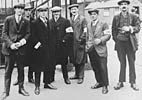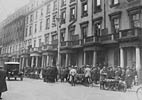The main strategy for the Strike was drawn up by the TUC Ways and Means Committee which was not established until 27 April, and none of the practical problems of carrying out its recommendations were tackled until 1 May. After the Special Conference of Union Executives was re-convened on 1 May, the General Council (GC) established a number of new committees to deal with particular problems and duties. The most important were Food and Essential Services (dealing with the distribution of food and the maintenance of health services), the Public Services (covering supply of electricity and gas), and Publicity (which controlled all public statements and arranged for printing leaflets and other propaganda material).
By 5 May, the GC's strike organisation was more established. The Council was meeting twice daily with a Strike Organisation Committee taking charge between meetings. The sub-committees were revised and extended to include an Intelligence Committee with resposibility for analysing all the reports received about the progress of the strike; an Interviewing Committee for dealing with callers at HQ; a Propaganda Committee for arranging speakers; and a General Purposes Committee, which acted as a clearing house and arranged transport and dispatches. Each of the Committees met and reported daily to the GC. In addition, there was a Political Committee of GC members who were also MPs to liaise with the Parliamentary Labour Party and a special Permit Committee to determine policy on releasing and transporting foodstuffs. Locally, the only bodies authorised to issue permits were joint transport committees composed of representatives of transport unions.
One of the most urgent tasks was the organisation of a system of communications. Those on strike were anxious for up to date instructions and news on what was happening elsewhere and the TUC needed feedback on local response to the call for sympathy action. Very few local union officials had telephones in 1926 and the post was interrupted by the cancellation of mail trains, so a network of dispatch riders were sent out from the TUC HQ in Ecclestone Square in London to bring back news or send coded telegramme reports. The coming and going of these messengers created a spirit of excitement and adventure in every town and village they passed. Local networks of messengers were also set up - travelling by bicycle or motorcycle, occasionally by car and very often on foot - to circulate local and regional news. Panels of Labour Party and other political speakers also toured the country speaking at open air meetings.
The TUC's strike newspaper, 'The British Worker', was printed on the presses of the Daily Herald. Despite a police raid on the evening of 5 May and a very restricted paper supply, the paper was successfully printed and distributed that evening. On 11 May, over half a million copies were printed in London, 70,000 in Manchester, 40,000 in Cardiff, 30,000 at Glasgow and 30,000 in Sunderland.
Christine Coates, TUC Library Collections Librarian
Click here to view documents and pictures









